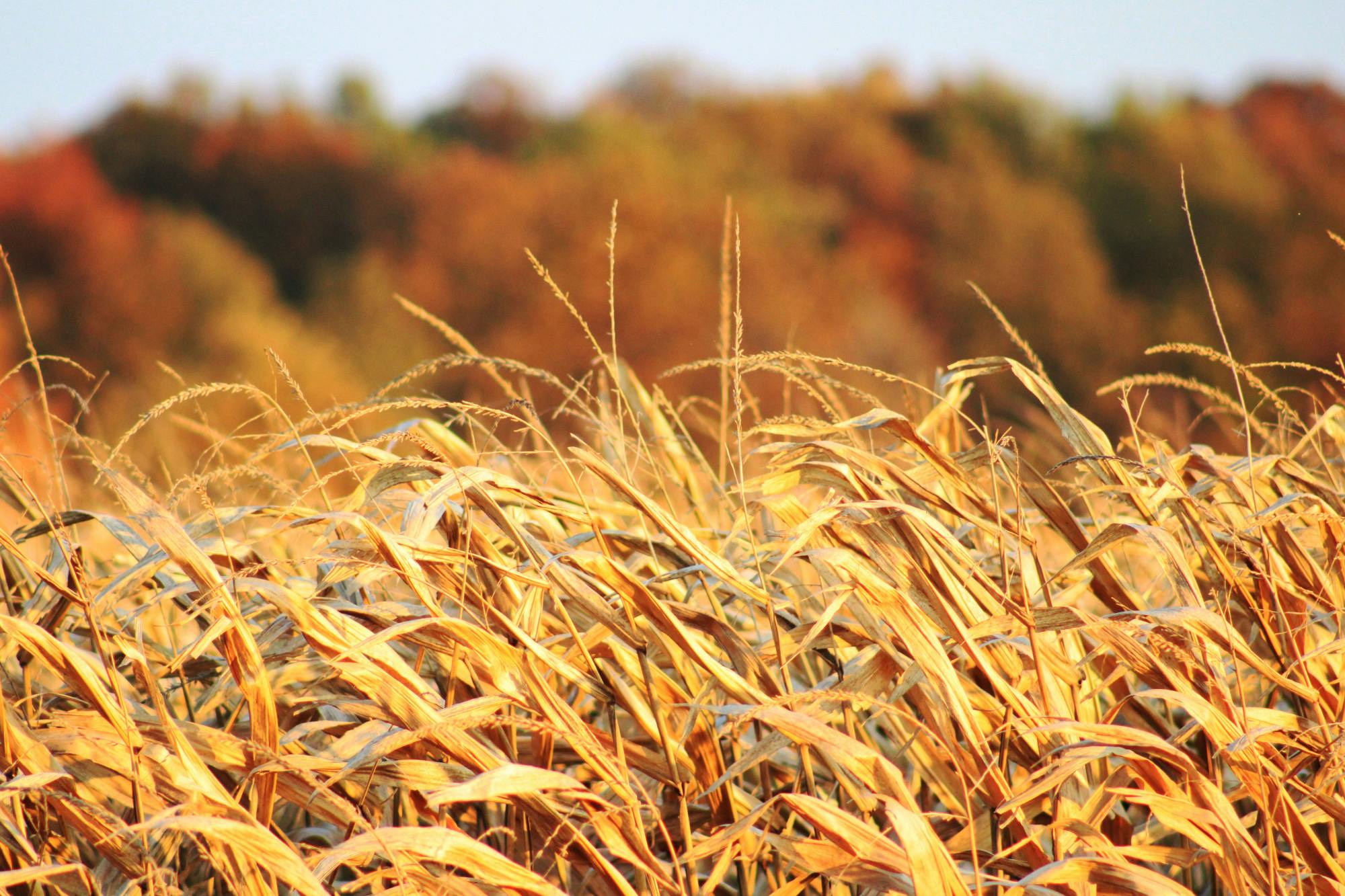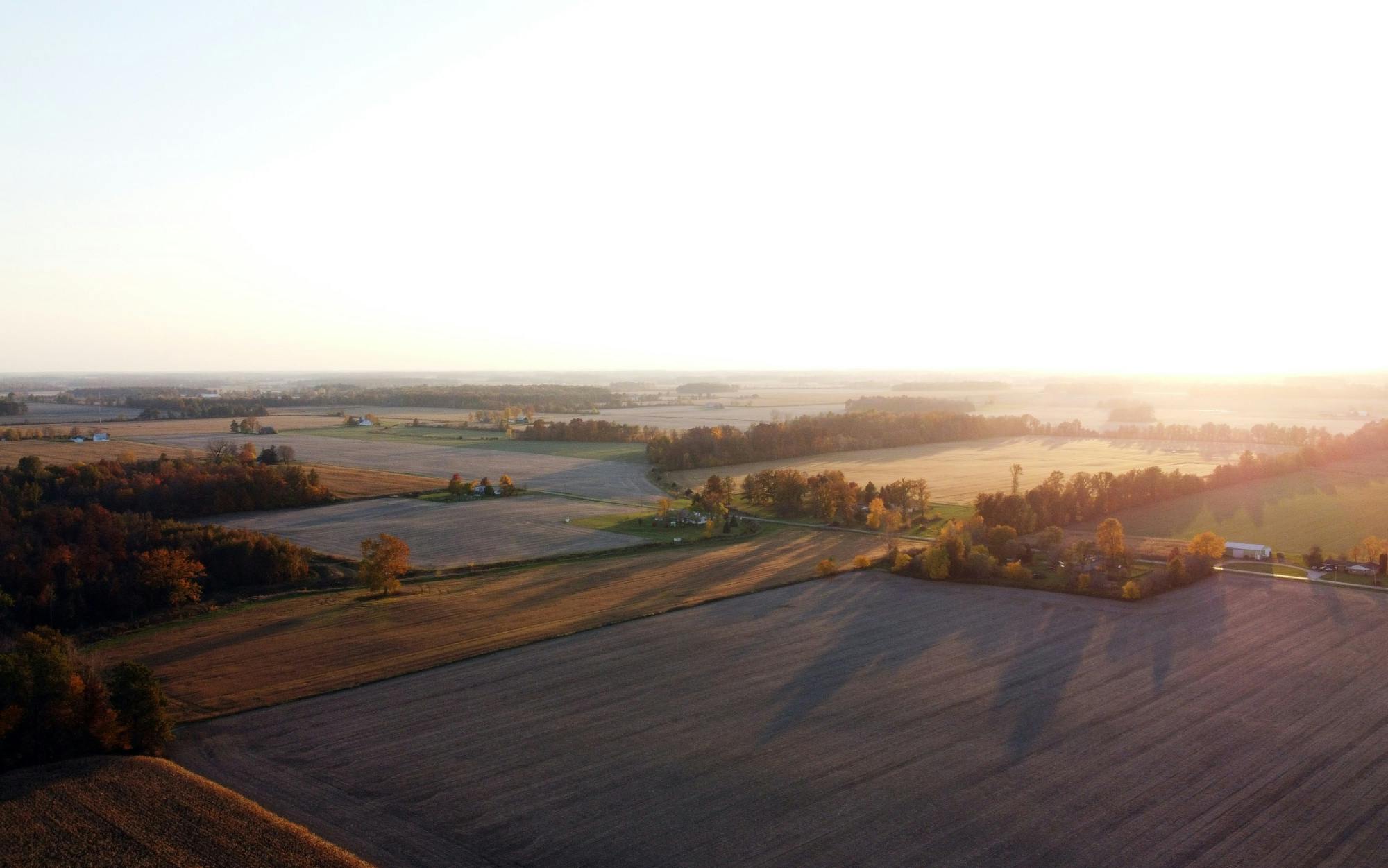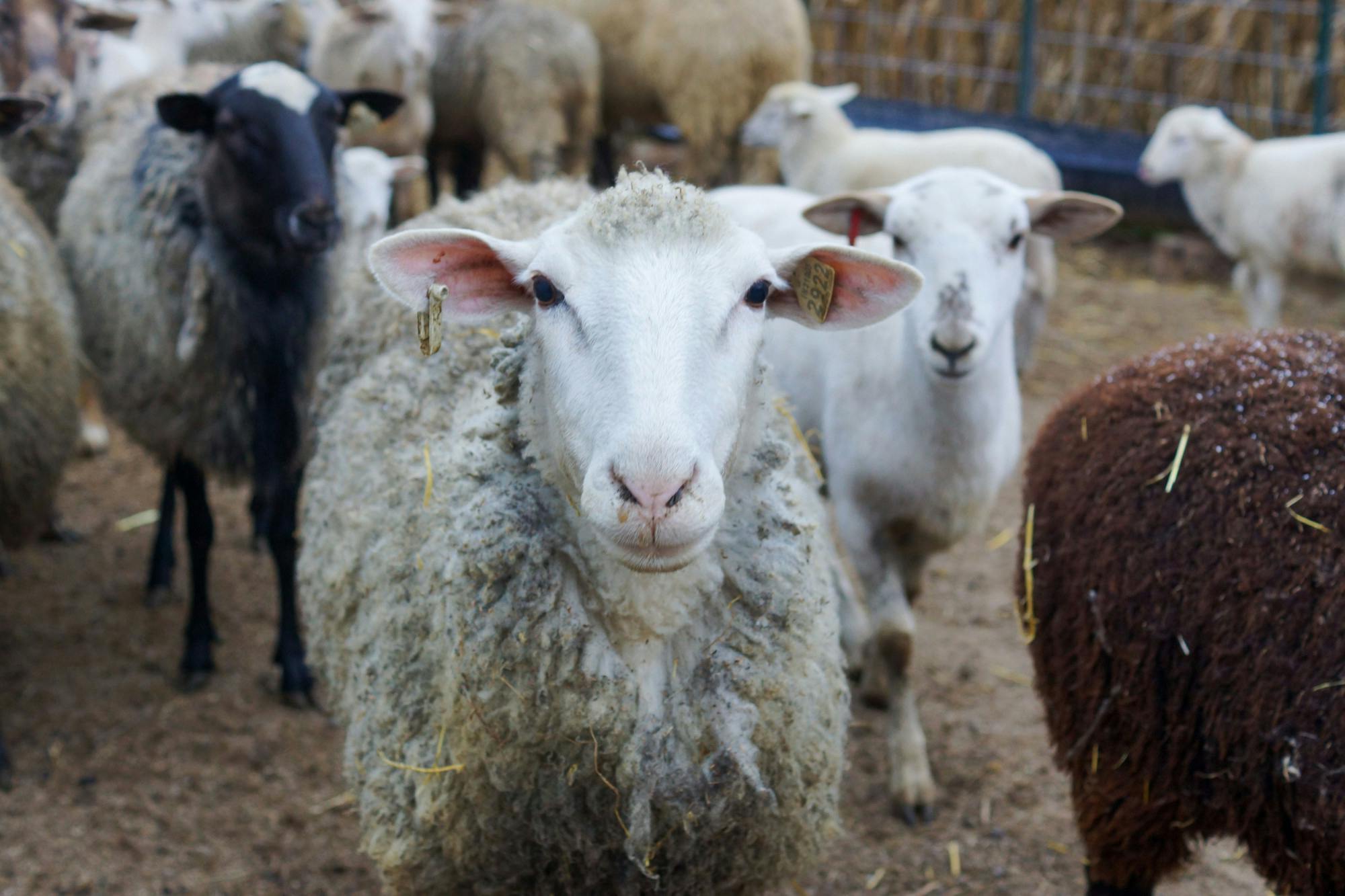Muncie residents might see farmers like Kody Light at Minnetrista Farmers Market, standing under a white tent selling meat from his cattle with the almost uniformed outfit of farmers–a Carhartt jacket and a baseball cap.
What they might not see is the watchful eye of Light and other farmers toward the sky, checking to see if the weather is starting to turn, wondering if their crop will be ready to harvest or if the rain will delay getting to the market to sell or if the cattle will have enough to graze. However, it is a life chosen despite all the challenges because they care for the product they are producing.
“A livestock producer, they have to be there,” Light said. "Seven days a week, 365 days a year. Whether you're sick you don't feel good, you take care of your animals.”
For farms around Delaware County, Indiana, and in several places around the Midwest, a summer drought has caused a familiar strain on farmers; a common problem in an area known for being a high-stress profession, as many are left at the mercy of weather, markets and their own mental state.
In the United States, farmers contribute $164.7 billion to the economy— about 0.7 percent of U.S. GDP, however those in the profession are faced with problems that do not seem to be obvious in picturesque depictions of the country and farms presented to the general public.
The summer's drought was not the worst on record, but it was another stressor to an already stressful industry.

Kody Light is a first-generation farmer who has been in the industry since 2011. He has a smaller farm with 30 acres of crops and some livestock including cattle and sheep. He said the drought this year brought memories of a much harsher year—2012.
“The corn was pollinating when the drought and the dry weather hit that year, and it really impacted the yield,” Light said. “I was from Northeastern Indiana and some had corn fields that should have been 150 bushels and did 10 bushels to the acre because the heat in the drought affected the pollination which affected the crop.”
Light, however, had soybeans that year, which have more of a chance against drought conditions.
“Soybeans can sometimes handle the drought and the weather a little better because they don't put pods on until August,” Light said. “So, the beans look crappy or terrible all summer long, but by the grace of God, luckily we got rain right at the time. We started selling pods so they didn't abort pods.”
According to the Ohio State University Extension Office, a bushel amounts to 56 pounds of corn kernels and 60 pounds of wheat. It is used to measure the amount of the crop to be sold in a market.
Jordan Morris, a senior originations merchant of Anderson Trade Group (who owns a grain elevator in Oakville, Indiana), manages the relationship between the sellers of the crop and the farmers.
The price of yields, whether it is bushel or any other form of crop, Morris said, relies on a market that is often changing based on local, national, and international changes and needs. A local market might try to adjust prices for an event like a drought, but not necessarily the national and international markets.
Light said agriculture is now a global market, and it is one thing people do not seem to understand about the industry.
“Across the country, we're going to have some areas that have had really bad droughts … but that doesn't necessarily mean we're going to get paid more for our crop,” Light said. “We also have to look at what South America's crops are doing and what our exports are doing. Farming is not like it was in the 1970s or the 1980s. There's a lot of geopolitical and global influences over our prices and in the interest rate hikes and different things the feds do or even what stockbrokers do.”
Despite this, Morris said this year’s crops, for most, will not be a huge loss for farmers, but also not the expectations originally guessed in early summer.
“It's all speculation, but back in the summer [the] USDA reported larger crop sizes, at least in the figures on paper,” Morris said. “Those have since continued to drop a little bit. But now as you're actually harvesting the crop, time will tell whether those numbers on paper are truly accurate in that.”
The estimations in the summer can influence the budgeting and planning of farms that have to decide months in advance how much to plant, what to plant and what they think their yields would be.
“In the summer, you could probably have penciled in, if you were a grower, somewhat larger yields, especially in early July,” Morris said. “We really hadn't experienced the stress yet. Some will say the stress following in late July and August and September hurt the crop; others will probably tell you it didn't hurt as much as you think. But the story is all told based on what your yields are when you're harvesting it.”
It is a high-stakes game between the farmer and Mother Nature. One that can change at any moment.

“You just notice the weather patterns, and you wonder what's going to happen,” Light said. “When 2012 hit, that was the first major drought issue I had with my crops. It was like, ‘When's it going to rain?’”
Another major player in the game is when the crops are planted, which can determine whether a yield will be impacted more or less by things like drought.
“There's different maturities on all your crops,” Collins said. “If you plant different maturities at the right time, sometimes, luck or your timing can help you out when the rains fall for the year and when your crop is needing rain the most. We got fortunate a few times this year, that helped us out.”
Crops are a gamble from when they are planted, but the impact is more immediate than with cattle. In the end, corn can grow faster than a beef cow.
In certain conditions, a farmer might have to slaughter or sell large amounts of the herd in a process called liquidation, according to Ohio State University’s College of Food, Agricultural, and Environmental Services.
“When a calf is born, if it's a heifer (a girl calf), it's about two years before she has her first calf,” Light said. “It'll be two years before you start seeing replacement heifers.”
In August, the USDA updated its Livestock Indemnity Program (LIP), which is a livestock disaster payment to help Midwest cattle farmers with the loss of their herd from drought and excessive heat over the summer.
While some have not lost their herd, the impact on the grain or grass they feed their cattle was impacted.
Ellen Brinkman has been a cattle farmer with her husband for 20 years, and they have not had to liquidate any of their almost 60-cow (and one bull) herd. Brinkman said they practice rotational grazing, where cows can eat from the field, but have already started to use the hay, which is usually reserved for winter because the pastures became too dry.
“I definitely would like to have had a little more hay,” Brinkman said. “We do a lot of our own haymaking, and we just didn't have quite as much as we wanted. But last year we used over 500 large round bales of hay just for the winter. Right now, I'm going into the winter with just a little over 300, so I definitely need some more.”

The question of getting more hay is not as certain.
“We're definitely done growing,” Brinkman said. “I'm hoping maybe I can do some winter grazing with some of our newer pastures. I've taken the cows off early enough that maybe they'll kinda bump up just a little bit. If we have a little bit of warmer weather, we might luck out on that.”
Luck plays a major role in some elements of farming, but it is hard to cite luck when finances plunge, especially as often only one or two people are in charge of all the business decisions of the farm.
“A farmer, he’s not just not a farmer but he's every facet of his business,” Morris said.
With roles from finances to soil conservation, a farmer has to take on roles they may not be comfortable with, or necessarily have a degree in, in order to properly manage a farm.
The financial stress is further deepened by a loan industry that, just like for every other American, is inflating.
“It makes me worry,” Light said. “I am a beginning farmer and still building equity and trying to build all those parts to a business. Interest rates have affected farmers that borrow money because they raised the interest rates. Most operating loans are at a variable interest rate. So every time they raise interest rates, operating notes go up”
Operation of a farm and land costs are part of a rising problem as many newcomers are unable to start in the industry.
According to the 2023 Purdue Agricultural Economics report, Indiana farmland had its “prices once again hit record highs.”
For farmers running on a small budget, the cost of land makes the idea of buying any more become impossible.
“That's something that makes it cost-prohibitive as a young farmer,” Collins said. “I'll never be able to buy anything in that price range, even with the advantages I have. It's just not feasible.”
Even when land is acquired, the equipment itself can pose a new problem.

“I'm advantaged to the point that I've got access to equipment I don't have to pay a rental fee to use,” Collins said. “I might not get to use it at the exact time I want [because] I’m at my dad's mercy as far as scheduling. That's something I'm okay with because you have to get your foot in the door somewhere and start small because there's not many cases where you can just go from not farming to stepping into farming.”
For those without the privileges of having a family nearby like Light, the market for equipment poses a problem.
“You could buy a decent one; there's old combines out there [and] you could spend $50,000 to $100,000,” Light said. “A new combine is about $1 million dollars with both heads; I would never be able to do that.”
Older farmers, Light said, told him to buy an older tractor or planter for $10,000 and fix it up, but he said the constant repairs would not make it worth it. Instead, he rents out equipment.
Barriers to land and equipment have made the path to farming increasingly inaccessible but also put pressure on long-standing farms to not lose what they have. For some children of farmers, however, they might not decide to continue on the farm.
“When I do talk to people that have been around, it is actually painful for them that their sons or daughters don't want to carry on,” Brinkman said. “It's just, it's just a different way now.”
Age is an increasing topic as young people seem to flee the industry.
According to the Indiana State Department of Agriculture, the average age of an Indiana farmer is 55.5 years old and 95 percent of farms are family owned or operated.
Numbers that could be subject to change with the next Census of Agriculture in 2024, for better or worse.
As prices soar and markets remain fluid, farmers are left in a state of stress and worry. A state that some never come back from.
According to a 2016 report from the CDC, for farmers, around 43.2 in every 100,000 civilian, noninstitutionalized working persons aged 16–64 years commit suicide. The Agriculture, Forestry, Fishing and Hunting industry is listed as one of the leading industries for suicide rates.
Remington Rice, health and farm stress educator at Michigan State University, helps run MSU Extension’s Managing Farm Stress site, which has resources for farmers helping them to deal with stress and manage their mental health.

Rice, a fifth-generation cattle farmer himself, is no stranger to the industry and its stressors. He grew up with a farmer father and a therapist mother, which he said gives him a unique perspective on the issue.
“There's these uncontrollable factors,” Rice said. “Farmers, they don't have a say in the weather or changing regulations of many parts [that] are out of their control. I'd also say finances are probably the number one thing we hear about. The drought – that's obviously going to affect your bottom line. There's so many factors that can impact what you're bringing in annually. You might have a salary, we can plan, we can expect, month after month, it's going to be stable. Whereas farmers, they may not be able to have the same stability”
For some, the stress of all the uncontrollable factors is too much.
“When you've got everything you worked your whole life for at stake on something you can't control, that can be rather nerve-wracking,” Collins said. “And when you get to where, 'Oh, we are gonna go broke.' For some people, they're faced with that harsh reality one day, where they do have to sell out, or move on to something else, or just work the day job and quit farming. There's some people that just don't want to do life without that.”
For farmers with a history of farmers behind them, the idea of failure can be an added pressure.
“There's the legacy of the farm,” Rice said. “If the farm has been in your family for five generations and you're the last generation to farm, you may feel like you have let down your ancestors.”
When all of the pressures mount, some find solace in their community.
“It almost feels like everything can be out of your control–the weather, the markets,” Light said. “Should I have contracted corn or locked in that price? Should I have bought now? Should I have sold now? You just have to have a network of good friends and buddies you can hang out with and just kind of look out for your neighbors.”

For Light, it is the community, but there are different solutions for everyone.
“It's going to be case by case, of course, but we all have coping mechanisms,” Rice said. “ Taking in the art of these beautiful landscapes that oftentimes we're working in and also doing that in non-work time”
Some, like Collins, find faith and a sense of calm indifference in moments of distress.
“I'm not a good Christian or anything, but I do believe in God and I do have pretty strong faith as far as when things are out of my control,” Collins said, “I just don't worry about it. If I worry about it. It's every year and you can worry yourself to death about a drought or if the crops are going to be okay or anything like that. But at the end of the day, you’re at Mother Nature's mercy and the mercy of the crop.”
Despite all the difficulties of the industry, there is something deep within those who continue on through the droughts and market shifts and hard times. Whether it means taking a second job or putting money into an endless pit of a farm or scrambling for a new venture to keep a family legacy afloat.
Brinkman, when she and her husband entered the industry 20 years ago, came to farming as a hobby after having fulfilled careers and entering retirement.
“No, we're not making a living from it,” Brinkman said. “We've already had our careers and this is just something we really love doing. But to have a family, I don't know what a young farmer does. The farming community we're involved in, very few of them have their children going into the business just because of that.”
Some, however, do follow their family despite the financial challenges, like Collins, who works a full time job as a foreman at in the day in order to keep his small acreage afloat.
“Anybody that does a nine-to-five understands the fact you're pretty consumed with your nine-to-five,” Collins said. “That's what you do, day-in day-out, and you want some time to be a person in between. With farming, you don't have all the time.”
Others, like Light, might be striking off on their own.
For most you ask, there is a similar theme to what they say is their calling–an appreciation for the land and stewardship of it.
“We might be in the fields sweatin’ really hard and it might be hot or it might be stressful because we've got a rain storm coming,” Collins said. “But farming, it's not meant to make money, it's meant to be enjoyed and for connection to happen. Because that's the passion, you want to be a steward, that's what gets fulfilled when you've had that experience.”
The industry might change, it might rise, it might fall, but for some farmers, it was never about the industry at all. It was about the almost primal connection to the land and being at its mercy.
Contact Abigail Denault with comments at abigail.denault@bsu.edu


Related Stories
Out of Touch: Local newspapers in Delaware County have been diminishing rapidly for years.
By Kaira Carter
Dyslexia is my superpower
By Isabella Kemper
Ball State claims victory in first home meet against MAC team
By Hannah Amos and Ella Howell
The Daily News welcomes thoughtful discussion on all of our stories, but please keep comments civil and on-topic. Read our full guidelines here.